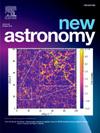The first CCD photometric study of the member eclipsing binary ZTF J060425.73+365000.1 in the newly discovered young open cluster UBC 68
IF 2.1
4区 物理与天体物理
Q2 ASTRONOMY & ASTROPHYSICS
引用次数: 0
Abstract
Multi-band photometric observations of the contact binary system ZTF J060425.73+365000.1 (hereinafter ZTF 06+36) are conducted using the 1.88-meter telescope at Kottamia Astronomical Observatory (KAO), Cairo, Egypt. This study presents the first photometric measurements and light curve analysis of this binary system. Analysis using the Wilson-Devinney (W-D) program reveals that the ZTF 06+36 system is an overcontact A-subtype system with a fill-out factor of 0.15 and mass ratios (q) of 0.34. To understand its evolutionary status, we investigated mass-luminosity, mass-radius, and mass-temperature relations. These relations indicate that the primary component of the system is the main sequence star, whereas the less massive component has evolved beyond the main sequence. Additionally, Gaia DR3 data is utilized to analyze the binary system's position on the color-magnitude diagram and evaluate its membership in the open cluster UBC 68. We combined two methods of machine learning algorithms (HDBSCAN and pyUPMASK) to obtain reliable stellar members of the UBC 68. They confirmed that the eclipsing binary
ZTF 06+36 has a membership probability of 1, indicating it is a member of the cluster. We also determined the physical parameters of the open cluster (UBC 68). Its age log(age), reddening E(BP-RP), and photometric distance are estimated to be 8.41±0.33 yr, 0.46±0.03 mag, and 2259±115 pc, respectively.
在新发现的年轻疏散星团UBC 68中,首次用CCD光度法研究了食双星ZTF J060425.73+365000.1
利用位于埃及开罗Kottamia天文台(KAO)的1.88米望远镜对ZTF J060425.73+365000.1(以下简称ZTF 06+36)接触双星系统进行了多波段光度观测。本文首次对该双星系统进行了光度测量和光曲线分析。采用Wilson-Devinney (W-D)程序分析表明,ZTF 06+36体系为过接触a型体系,填充系数为0.15,质量比(q)为0.34。为了了解其演化状态,我们研究了质量-光度、质量-半径和质量-温度的关系。这些关系表明,该系统的主要组成部分是主序星,而质量较小的组成部分已经演化到主序星之外。此外,盖亚DR3的数据被用来分析双星系统在色星等图上的位置,并评估它在疏散星团UBC 68中的隶属关系。我们结合了两种机器学习算法(HDBSCAN和pyUPMASK)来获得可靠的UBC 68恒星成员。他们证实了食双星ztf 06+36的隶属概率为1,表明它是该星团的一员。我们还确定了疏散星团(ubc68)的物理参数。估计其年龄对数(age)、变红E(BP-RP)和光度距离分别为8.41±0.33 yr、0.46±0.03 mag和2259±115 pc。
本文章由计算机程序翻译,如有差异,请以英文原文为准。
求助全文
约1分钟内获得全文
求助全文
来源期刊

New Astronomy
地学天文-天文与天体物理
CiteScore
4.00
自引率
10.00%
发文量
109
审稿时长
13.6 weeks
期刊介绍:
New Astronomy publishes articles in all fields of astronomy and astrophysics, with a particular focus on computational astronomy: mathematical and astronomy techniques and methodology, simulations, modelling and numerical results and computational techniques in instrumentation.
New Astronomy includes full length research articles and review articles. The journal covers solar, stellar, galactic and extragalactic astronomy and astrophysics. It reports on original research in all wavelength bands, ranging from radio to gamma-ray.
 求助内容:
求助内容: 应助结果提醒方式:
应助结果提醒方式:


